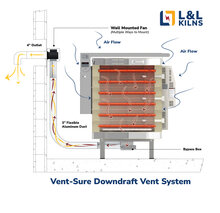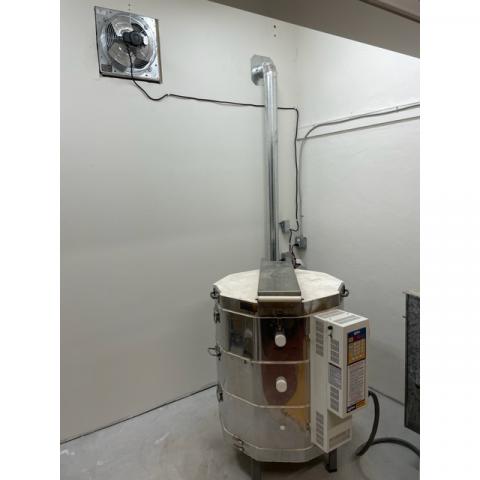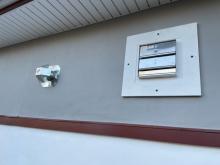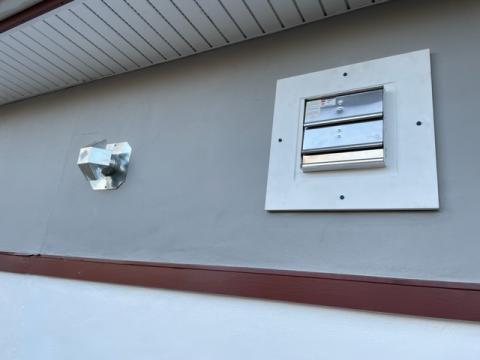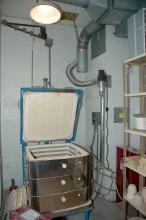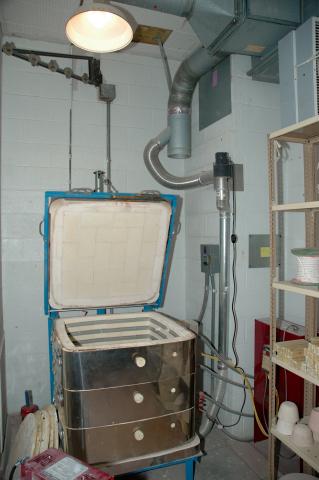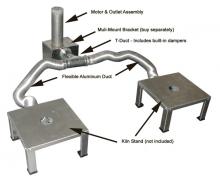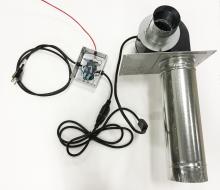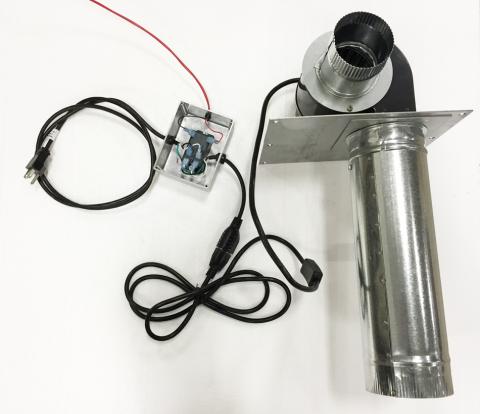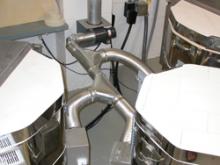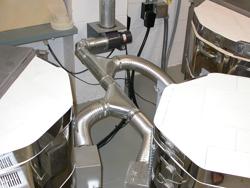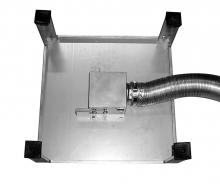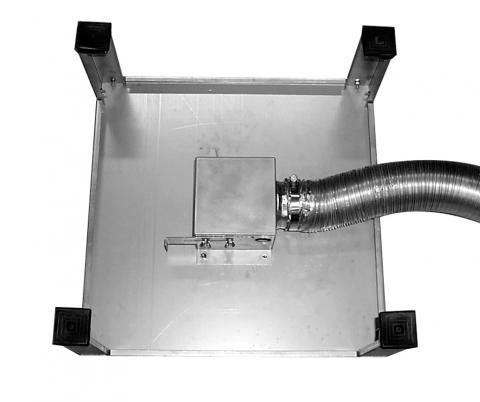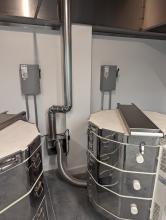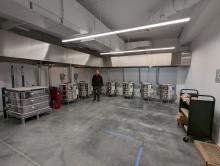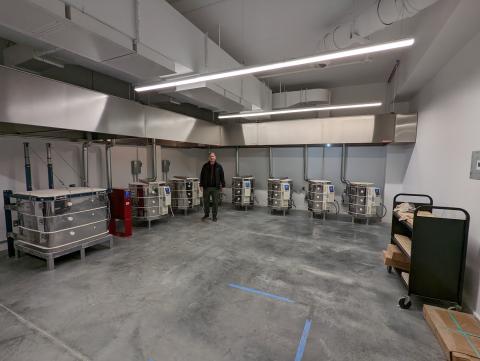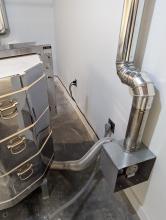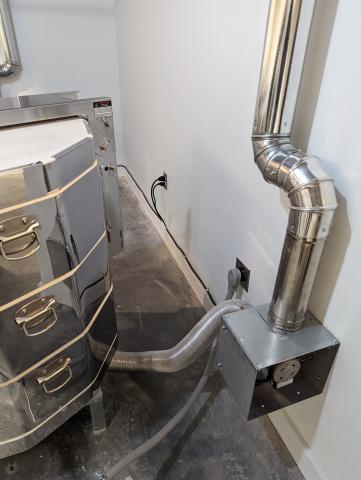An electric kiln atmosphere rich in oxygen will make elements, kiln-sitters, and thermocouples
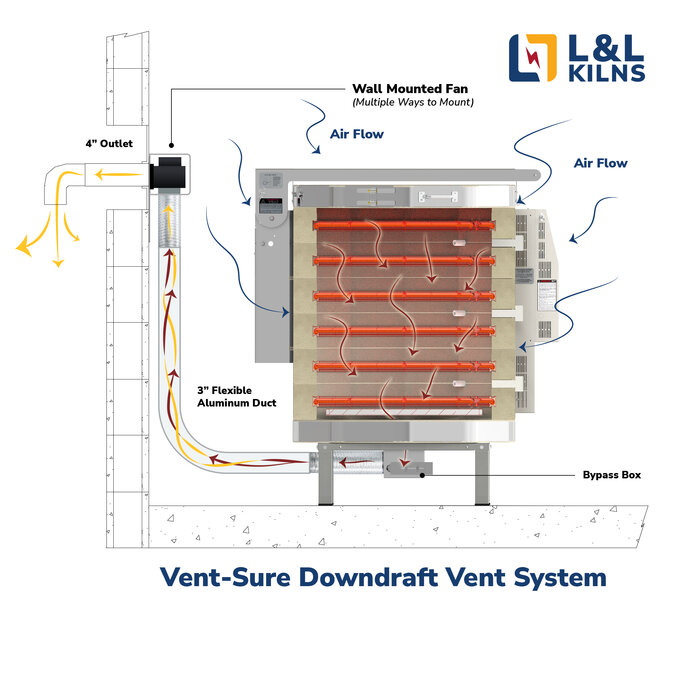
Why and How to Ventilate Your Kiln and Kiln Room
Ventilation is Essential:
- Kilns generate harmful fumes, including carbon monoxide, formaldehyde, sulfur dioxide, heavy metal vapors, and fluorides.
- Install the kiln in a well-ventilated area.
- Never operate in an enclosed space, such as a closet, without proper ventilation to avoid fire hazards and toxic fumes.
- Good ventilation minimizes severe corrosion caused by kiln fumes, salt air, or other environmental conditions.
- Ventilation must be to the outside.
- We recommend room ventilation of at least 100 times the cubic feet of the kiln per minute. For example, a 7 cubic foot kiln requires 700 CFM.
- Use a variable speed fan for ambient room ventilation and keep a thermometer on the wall to adjust ventilation as needed.
Ventilation for the Kiln:
- We recommend the VENT-SURE downdraft kiln vent system for effective fume venting, improved firing uniformity, and maintaining oxygen levels in the kiln.
- Refer to the separate instructions for the VENT-SURE vent system.
- The VENT-SURE is c-MET-us listed for use with L&L kilns. If listing is important, check with local authorities or the vent manufacturer for compatibility with your kiln model. More information is available at hotkilns.com/vent-sure.
Carbon Monoxide Monitoring:
- Use a carbon monoxide monitor in your kiln room.
Venting Codes:
- OSHA standards for carbon monoxide exposure are 35 ppm for long-term and 200 ppm for short-term exposure.
- Independent tests show kiln fumes can exceed 200 ppm during greenware firing, causing health issues. Proper downdraft vent installation removes harmful fumes.
- Most states and localities have venting requirements for public kiln firing. Check with your local and state health board.
- The Uniform Mechanical Code requires venting ceramic kilns using either a canopy-type hood or "listed exhaust blowers" marked suitable for the kiln.
- The Vent-Sure vent meets this requirement and is UL listed. If using a different vent, ensure it is approved for use with your kiln. L&L is not responsible for improper vent installation or use of unapproved vents.
Note about Canopy Type Vent Hoods:
- Canopy type vent hoods are suitable for safety but do not offer the advantages of downdraft vents like Vent-Sure.
- Downdraft vents pull rising hot air down, evening out the firing and distributing oxygen uniformly in the kiln.
HVAC and Air Conditioning Issues:
- Kilns emit significant ambient heat. Use the BTU output charts on the General Dimension Drawings for sizing HVAC units.
- The charts show BTU output for steady-state conditions, providing safe figures for HVAC system sizing.
- Voltage does not affect BTU output. See hotkilns.com/calculate-kiln-room-ventilation to calculate heat ventilation requirements.
Other Safety Concerns:
- Check the temperature of the flexible ductwork while the kiln is at its maximum temperature. Most flexible aluminum ductwork is rated for at least 350°F, so if it is hotter than the rating, you should plug up at least one hole using high-temperature cement or other high-temperature fiber products.
- Be careful using wax resist: wax may condense on the inside of the aluminum ductwork, which could be dangerously flammable. You should check this periodically and clean the fan motor and inside of the ductwork to remove any residue, particularly wax resist.
Calculating Heat Ventilation Requirements:
Room Ventilation Guidelines: Aim for room ventilation that provides adequate air exchange to maintain a safe working environment. A general guideline is to achieve ventilation at 100 times the cubic feet of the kiln per minute. For instance, an e23T-3 has approximately 7 cubic feet. Multiply that by 100 and get 700 cubic feet per minute.
How downdraft ventilation helps your work and your kiln
Kiln Life: Ventilation significantly impacts kiln efficiency. It facilitates the removal of harmful byproducts, such as carbon dioxide and volatile organic compounds, allowing your kiln to operate more effectively and safely. Maintaining a balanced airflow can enhance firing outcomes and reduce potential issues. The increased oxidation and removal of acids generated in the ceramic process improves glaze colors and helps element life and kiln corrosion.
Firing Consistency: Appropriate ventilation promotes consistent firing results. You can achieve uniform firing across your ceramics by preventing temperature variations and uneven heat distribution. Consistency is key for obtaining desirable glaze finishes and preventing defects.
Tips for Effective Ventilation
- Adequate Airflow: Use proper venting systems to ensure a consistent flow of fresh air into the kiln and kiln room. This prevents the buildup of contaminants and supports optimal firing conditions. Use a kiln ventilation system specifically designed for your kiln whenever possible.
- Vent Placement: Downdraft vents effectively remove contaminants and promote uniformity in the kiln by counteracting the flow of heat upwards. Hood vents can be helpful for removing heat and fumes from the room but are not as good for promoting kiln uniformity.
- Ventilation Control: Maintain control over your kiln's ventilation system to achieve desired firing outcomes. Adjusting the speed and direction of airflow allows for fine-tuning the firing process. Keep a balance between intake and exhaust to optimize the combustion and release of byproducts.
- Monitoring and Maintenance: Regularly inspect and clean your ventilation system to ensure its optimal performance. Remove any obstructions that may hinder airflow and check for wear and tear. Additionally, monitor the kiln's temperature and gas emissions to promptly identify and address any ventilation-related issues.
Accessories
Do You Need A Vent Control?
- A vent control system lets you set the vent to turn on or off during different stages of the firing process.
- This gives you more control over the firing and reduces the air vented from the kiln and the room.
- Most fumes are produced at specific times during the firing process.
- You can get a vent control for most L&L kilns here
Can You Vent Two Kilns With One Vent?
- One vent can handle up to 20 cubic feet of kiln capacity so you could vent two 10 cubic feet kilns (two e28T-3 kilns for instance) with one vent.
- You can purchase a Vent Doubler to do this.
KILN VENTILATION RESOURCES
INSTRUCTIONS
PRICING & SPECIFICATIONS
Vent-Sure Vent System Features and Pricing
Vent Control Features and Pricing
CAUTIONS
KILN ROOM VENTILATION
Calculating Ventilation Requirements for your kiln room
TROUBLESHOOTING & PARTS
EXTERNAL RESOURCES
The Edward Orton Jr. Ceramic Foundation (information on ceramics, firing, cones, and venting
KILN VENTILATION KNOWLEDGEBASE
The duct can be 60 feet in length and include up
It is fine to go through a roof with the L&L Vent-Sure kiln fumes vent system.
Question: We received this semester a DaVinci 2327-D and I'm hoping you can help us with some
The motor extends 7" off the wall. Motor dimensions are 8" x 7". Wall plate dimensions are 10" x
What is the recommended temperature to turn off the Vent-Sure kiln vent when firing glazes,
This question gets asked a lot around the holidays. L&L's official line on cooling the kiln
A customer asks if he can interlock his automatic kiln so that it will not fire unless his
Although we strongly recommend using the Vent-Sure downdraft
Corrosion on a kiln is perfectly normal... mostly because it is a kiln! Hot-to-cold-to-hot
Problem: You have a room ventilation system that is external to your kiln, and you want to turn


